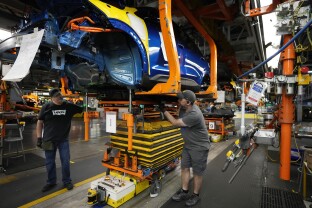The nation’s largest piece of climate legislation turned two years old this week, and a few things are certain: The Inflation Reduction Act has spurred far more investment in clean energy than first estimated, and it is likely going to cost the government at least double — and possibly triple — what original estimates said it would.
Why the $1 trillion in budgetary costs over the next 10 years? Because the policy is popular with businesses and consumers, and there’s a lot of demand for the uncapped financial incentives the law provides for clean energy production and electric vehicles. U.S. taxpayers are paying less and the government is paying taxpayers more to adopt cleaner practices.
The law is the primary driver behind $493 billion in business and consumer clean investment over the first two years of the legislation’s existence, an increase of 71% from before the bill was enacted, according to an August report from the Clean Investment Monitor.
Even some Republican lawmakers are on board, despite voting against the bill and campaigning against Biden’s clean energy goals. Last week, 18 Republican House members who originally opposed the legislation wrote to Speaker Mike Johnson asking him to protect the already deployed energy tax credits in the bill, citing ongoing business investments in their districts.
“A full repeal would create a worst-case scenario where we would have spent billions of taxpayer dollars and received next to nothing in return. Energy tax credits have spurred innovation, incentivized investment, and created good jobs in many parts of the country — including many districts represented by members of our conference,” the Republicans, several of them in competitive House races, wrote in the letter.
More than 50% of the investments from the IRA have gone to Republican districts, a statistic touted by senior White House Climate Adviser John Podesta at an event celebrating the anniversary this week.
“Some Republicans, especially governors, know that all of this activity is actually a good thing,” Podesta said.
Gov. Greg Gianforte in Montana celebrated a $700 million Department of Energy grant for a transmission project earlier this month. Oklahoma Gov. Kevin Stitt lauded the launch of the country’s largest direct air capture facility on Aug. 13.
Meanwhile, former President Donald Trump has vowed to undo the IRA, and in the House, Johnson has attempted to repeal all or parts of the IRA dozens of times.
Energy policy experts from the electric vehicle industry and renewable energy development lobby have told NOTUS over the last several months that they feel increasingly confident that the tax credits are too popular in Republican districts to face significant repeal challenges if Republicans take control of Congress in the November elections.
When asked about those pushing for a full repeal of the IRA, Podesta said he believes that some Republicans are starting to see that as “bad politics, not just bad policy.”
Initial estimates put costs for the IRA’s tax credits at around $400 billion over the 10 years.
In February 2024, the Congressional Budget Office estimated that the energy credits from the Inflation Reduction Act would cost $25 billion more in 2024 and $428 billion more between 2024 and 2033 than originally forecast. A group of economists estimating for Brookings calculated that the tax credits will cost somewhere between $780 billion and just over $1 trillion across the 10-year period. Goldman Sachs put the number at $1.2 trillion, and Credit Suisse put the number at greater than $800 billion.
Neil Mehrotra, a former economist in Biden’s Treasury department, said the CBO and Joint Committee on Taxation did not accurately calculate the popularity and uptake of electric vehicles, failed to predict the enthusiasm for new, unproven technologies like carbon capture and clean hydrogen and had no way of knowing how Biden administration regulations would further spur investment. Most of the administration’s environmental regulations were only finalized in the last few months.
(In February, the Committee for a Responsible Federal Budget estimated that the Biden administration’s vehicle emissions standards would alone account for two-fifths of the total tax credit cost increase.)
“I think the official scorekeepers did the best they could given their resources and their expertise, and given the technical nature of this legislation, but it’s a hard thing to figure out, and they weren’t super well equipped to figure it out,” Mehrotra said.
The Treasury Department and some climate economists argue that the costs will create a level of clean economic growth that will far outweigh the budgetary impacts. One frequently cited study from Conor Walsh, a researcher at Columbia Business School, found in August 2023 that the IRA will more than pay for itself despite the increasingly high costs, an argument the Biden administration’s Treasury Department also made to NOTUS.
“This really shows that the positive socioeconomic tipping point that many of us have been talking about is, in fact, happening,” said Gernot Wagner, a climate economist at Columbia who was the former director of Harvard’s solar geoengineering research program, a program that studies the controversial idea of manipulating the environment to mitigate the effects of climate change.
“It’s good news that the Inflation Reduction Act’s clean energy tax credits are popular with American companies and consumers, indicating that the law is working as intended: lowering costs for consumers, spurring a clean energy manufacturing boom and strengthening energy security,” said Michael Martinez, a Treasury Department spokesperson.
But not every climate economist takes such a strong positive view of the ballooning costs, especially if Congress moves to renew Trump’s 2017 tax cuts next year. Several economists told NOTUS that they anticipate the tax cut debates will target the unexpectedly high IRA costs, especially because lawmakers may be searching for compromise areas to make cuts.
Some deficit hawks are already making that argument: One Cato Institute report argued that repealing the tax credits would allow for a “pro-growth tax code.”
Catherine Wolfram, an MIT economist who helped calculate the Brookings estimate for IRA costs, argued that some of the investments in clean energy would have happened regardless of the tax credits.
“If electric vehicles really take off and become cheap, it’s likely a fair number of purchases would happen anyway,” Wolfram said. Wolfram is still excited about the growth coming from the IRA, but she believes it is important to consider when the money might be better used elsewhere. “Imagine if you could get a tax credit worth more than the value of the car — that just highlights the danger of having these uncapped tax credits.”
Elaine Buckberg, the former chief economist at General Motors and now a senior fellow at Harvard, similarly argued that while the climate consequences are clearly positive, “there are budget consequences.”
“And we have not done this analysis, but it would be an interesting analysis to ask: At different estimates of the social cost of carbon, is this a good deal?” she asked.
For example, Buckberg suggested Congress could end the tax credit when 50% of new car sales go to EVs, a sure sign that the market should be self-sustaining and widespread adoption has been achieved.
Not all are on board. Wagner said compromising on the IRA would have “the most negative consequences that could happen.”
“That would be bad because those tax credits, in fact, lead to growth. Purely from an economic perspective, they are good, and this now is raw politics,” Wagner said.
—
Anna Kramer is a reporter at NOTUS.
Sign in
Log into your free account with your email. Don’t have one?
Check your email for a one-time code.
We sent a 4-digit code to . Enter the pin to confirm your account.
New code will be available in 1:00
Let’s try this again.
We encountered an error with the passcode sent to . Please reenter your email.


